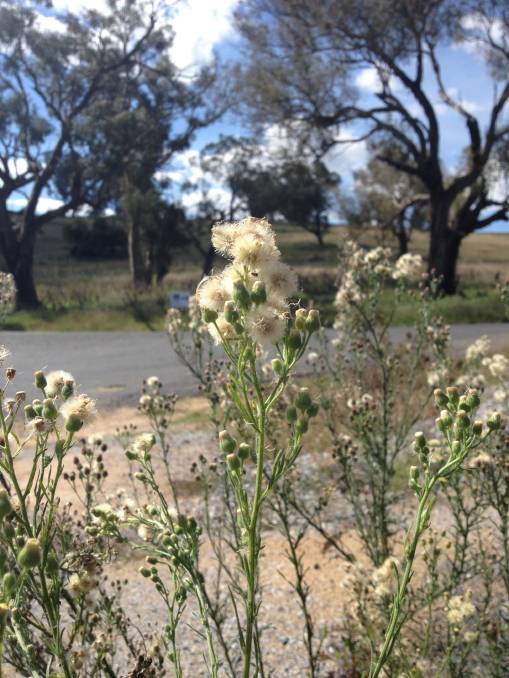A novel approach to weed management in Australia is being investigated with the start of a project that aims to research the economic and social benefits of tackling weeds on a broader scale.
The project, "Area-wide management for cropping system weeds - investigating the weed management, social and economic opportunity", aims to take a new approach to weeds.
Dr Jason Emms, GRDC manager, weeds, says the traditional approach to tackling weeds has been at a paddock or farm level.
This project aims to take an area-wide approach across three pilot areas: the Darling Downs, the Riverina and Sunraysia.
Since the same weeds often cross over different crop types, these areas were chosen because they have multiple agricultural industries side by side.
"The Darling Downs has cotton and grains. The Riverina has grains, cotton, horticulture, viticulture and rice. And Sunraysia has grains, viticulture and almonds.
 Flaxleaf fleabane flourishes along roadsides and fencelines. Photo: Sarah Clarry
Flaxleaf fleabane flourishes along roadsides and fencelines. Photo: Sarah Clarry
"This project is about collaboration. It is a cross-industry approach so although GRDC is the project's lead research and development corporation, another 10 R&D delivery partners are involved," Dr Emms says.
These are: Cotton Research and Development Corporation, AgriFutures Australia, CSIRO, University of Queensland, University of Adelaide, Millmerran Landcare Group, Irrigation Research & Extension Committee Inc., Mallee Sustainable Farming and the Toowoomba Regional Council.
The project, funded by the Australian Government Department of Agriculture as part of its Rural R&D for Profit Program, will explore whether area-wide management fits in a cropping system context and, if so, what are the advantages but also what are the barriers to adoption.
Dr Emms says the theory is that if the number of weeds over the entire landscape can be reduced, everyone in that area should benefit.
CSIRO's Dr Rick Llewellyn, research group leader, agricultural systems, will lead the project. "We hear a lot about potential weed issues and their ability to move across farm borders," he says.
"This includes herbicide resistance spread, new weeds entering districts, spray drift, and weeds spreading after floods. We know there's a substantial proportion of growers who believe that they've gained a weed problem from movement from outside of their farm. This project is all about finding cases with likely high payoffs and what it would take for a more collaborative approach to be attractive and successful."
The project has five components:
- establishing local area-wide management groups in the three focus areas;
- evaluating suitable weed management tactics that may be useful in targeting highly mobile weed species;
- evaluating the economic aspects of area-wide weed management;
- understanding the social attitude to area-wide weed management; and
- understanding the spatial aspects of the landscape and associated potential for area-wide weed management.
By understanding the benefits and key principles which influence successful area-wide weed management, Dr Emms says, localised approaches can be designed and implemented in other regions.
He says he has been surprised and encouraged by how many times growers have mentioned the concept of a broader weed management approach. "I often hear: 'whatever a neighbour is doing, it impacts on us too'."
Pest management is often thought of on a broader scale and, although weeds are not as mobile as some pests, some, such as fleabane and feathertop Rhodes grass, move across property boundaries and so the same concepts may apply.
Dr Llewellyn says that although focusing on managing weeds at the individual farm level will always be the obvious approach, "we expect that there are some cases where growers will gain from taking an area-wide or team-based approach. Preventing the spread of a potentially costly new weed into a local district or the spread of a costly form of herbicide resistance could have major economic advantages. The key is finding the cases where it is well worth doing and can be done relatively easily and we're working with local farmer groups to do that.
"We have increasing numbers of grain growers with new neighbours - that may be cotton entering new regions, or horticulture and viticulture alongside grain farms. There's also a lot of public land that is part of the weed landscape, like roadsides. All of these factors together mean that it is a good time to look at when and where it may be worth growers and landowners doing more to tackle some of the weed risks and mobile weed issues at a local level, not just the individual grain grower level."
The concept, while new, has been tried in other countries and in other situations in Australia.
"We have seen a co-operative approach when it comes to management of weed incursions of new or environmental weeds," Dr Llewellyn says.
"Think of the spread of a weed across grazing regions and attempts to manage declared plants in local catchments or irrigation areas. It can be done, but we see less of it in grain growing regions where managing common weeds at a paddock level is the usually the most feasible approach.
"However, with a lot of growers having experienced gaining a weed incursion through mobility, we expect there will be interest in looking at the specific cases where the overall risks and costs can be reduced."
More information: Jason Emms, 0439 549 950, jason.emms@grdc.com.au; Rick Llewellyn,08 8303 8502, rick.llewellyn@csiro.au

























































